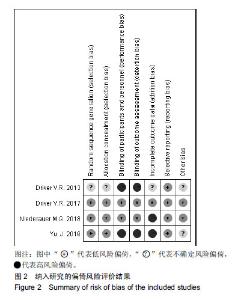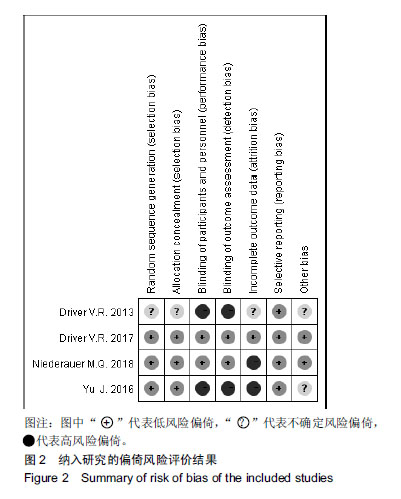Chinese Journal of Tissue Engineering Research ›› 2019, Vol. 23 ›› Issue (23): 3767-3772.doi: 10.3969/j.issn.2095-4344.1261
Transdermal continuous oxygen therapy repairs diabetic foot ulcer: a systematic review
Yang Qi, Zhang Yonghong, Lu Yanjun
- (Department of Traumatic Orthopedics, the Second Clinical Medical Hospital of Shanxi Medical University, Taiyuan 030001, Shanxi Province, China)
-
Received:2019-02-05Online:2019-08-18Published:2019-08-18 -
Contact:Zhang Yonghong, Chief physician, Department of Traumatic Orthopedics, the Second Clinical Medical Hospital of Shanxi Medical University, Taiyuan 030001, Shanxi Province, China -
About author:Yang Qi, Master candidate, Physician, Department of Traumatic Orthopedics, the Second Clinical Medical Hospital of Shanxi Medical University, Taiyuan 030001, Shanxi Province, China
CLC Number:
Cite this article
Yang Qi, Zhang Yonghong, Lu Yanjun. Transdermal continuous oxygen therapy repairs diabetic foot ulcer: a systematic review [J]. Chinese Journal of Tissue Engineering Research, 2019, 23(23): 3767-3772.
share this article
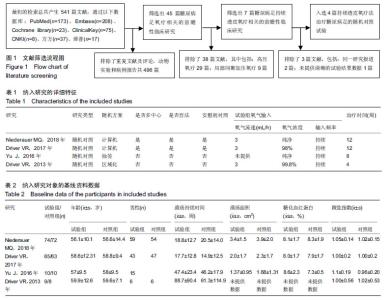
2.1 检索结果分析 最初检索到541篇文献,通过筛选题目、摘要及全文,最终纳入4项随机对照研究[9,12-14],均为英文文献,其中3篇研究来自美国,1篇研究来自加拿大;纳入研究的样本量范围为17-146,所有收录的研究均作为期刊文章发表。试验的筛选过程如图1所示。 纳入研究的详细特征见表1,研究对象的基线资料数据见表2。 2.2 质量评价 纳入研究均被描述为随机化试验,3项研究详细报告了随机方法[9,12,14],2项为计算机随机,1项为抽签法,因此判断其偏倚风险较低;有3项研究报道了分配过程[9,12,14],因此认为它们的偏倚风险较低;2项研究报道为双盲试验[9,12],且均描述了盲法细节;2项研究结果数据存在缺失可能[12,14],因此认为其偏倚风险较高。纳入研究的偏倚风险被示于图2中。"
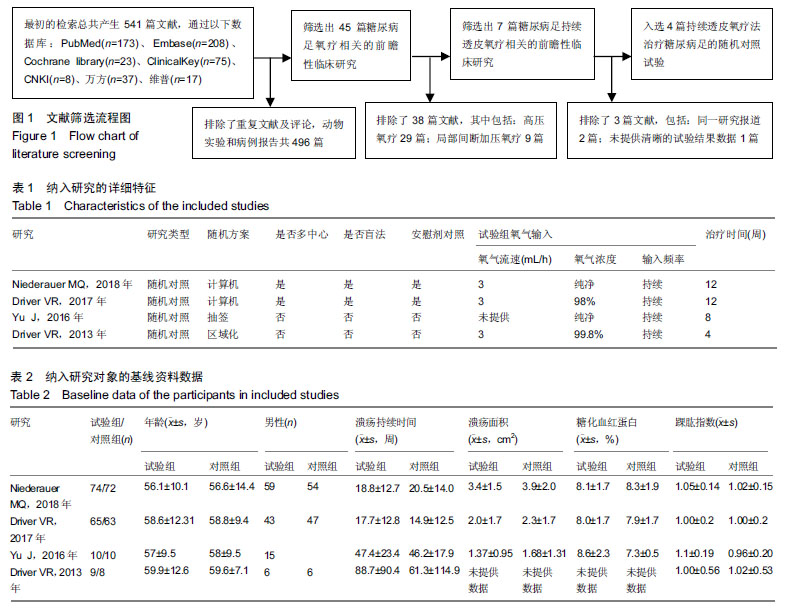
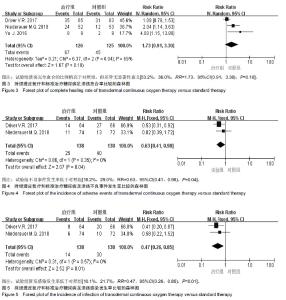
2.3 Meta分析结果 2.3.1 伤口愈合(在治疗期间溃疡完全愈合的比例) 共3项研究包括251例参与者显示了在治疗期间溃疡完全愈合的比例[9,12,14],这3项研究的随访时间分别为12周[9],12周[12],8周[14]。各研究间存在实质的异质性(P=0.04,I2=69%),故选用随机效应模型。结果显示:与对照组相比,试验组溃疡完全愈合的比例较高,但差异无显著性意义[53.2%,36.0%,RR=1.73,95%CI(0.91,3.30),P=0.10],见图3。由于纳入文献较少,估计的置信区间很宽,结果较为保守。 2.3.2 溃疡面积/体积变化率 1项研究报道了治疗开始后8周内每周溃疡面积的变化[14],包括18例参与者,结果为:试验组溃疡面积在第2-8周较基线伤口大小显著减小[第2周(P < 0.016),第3周(P < 0.09),第4周(P < 0.002),第5周(P < 0.001),第6周(P < 0.001),第7周(P < 0.001),第8周(P < 0.001)],对照组伤口面积大小变化无显著性意义[F(1.186,10.674)=1.447,P < 0.262]。由于研究样本量少,原始试验的偏倚风险不明确,证据质量低。 1项包括17例参与者的研究报道了治疗开始后4周内溃疡体积的变化[13],第4周时,试验组溃疡体积减少约87%(55.7%-100.0%),对照组减少约46%(15%-99%),试验组第4周溃疡体积减少百分比显著高于对照组(P < 0.05)。但由于结果数据未具体描述且样本量少,原始试验的偏倚风险不明确,证据质量低。 2.3.3 完成伤口愈合的时间 没有研究报道该结果的有效数据。虽然2篇文献报道了溃疡愈合的中位时间[9,12],但因为并非所有的溃疡都得到了治愈,所以对溃疡愈合时间的评估并不可靠,未将数据进行定量分析。 2.3.4 不良事件发生率 共2项研究包括276例参与者报道了不良事件的发生信息[9,12],所报道不良事件种类包括患肢伤口周围感染、水肿、脓肿、骨髓炎、坏疽、再截肢、菌血症。使用固定效应模型分析得出结果:与对照组相比,试验组不良事件发生率较低[18.2%,29.0%;RR=0.63,95%CI(0.41,0.98),P=0.04],见图4。 2.3.5 感染发生率 共2项研究包括276例参与者报道了溃疡周围感染的相关信息[9,12]。使用固定效应模型分析显示,试验组新发感染发生率较对照组更低[10.1%,21.7%;RR=0.47,95%CI(0.26,0.85),P=0.01],见图5。 2.3.6 坏疽/截肢发生率 共2项研究包括276例参与者报告了坏疽/截肢的发生信息[9,12],结果为试验组无坏疽或截肢发生,对照组有1例参与者发生截肢,3例参与者发生足部坏疽。因为样本量及阳性结果均较少,未对其行统计学分析。"
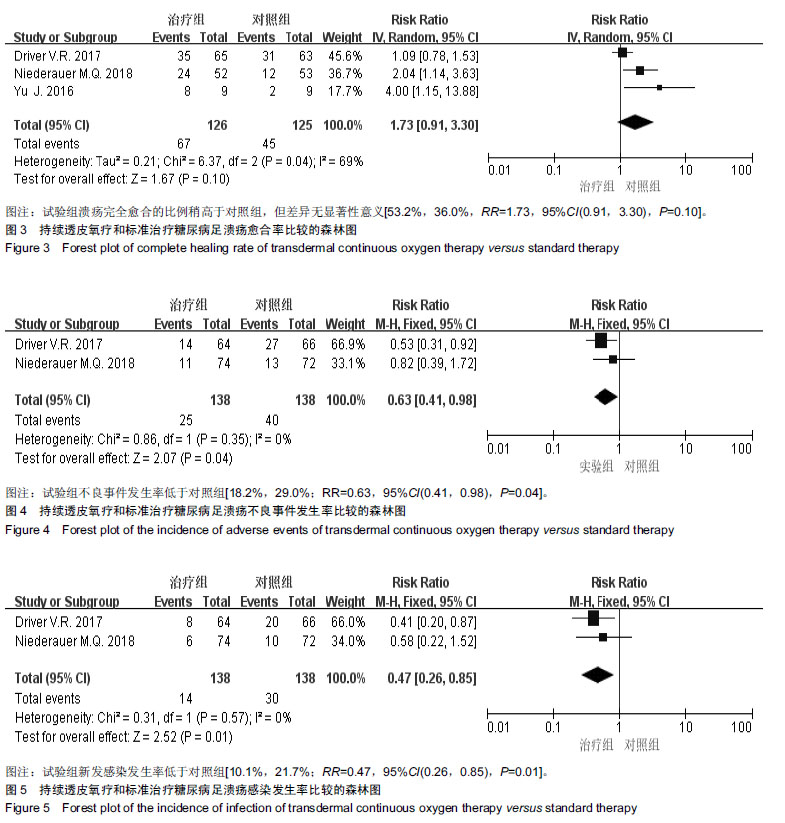
| [1]Lipsky BA,Berendt AR,Cornia PB,et al.2012 Infectious Diseases Society of America clinical practice guideline for the diagnosis and treatment of diabetic foot infections.Clin Infect Dis. 2012;54(12):e132-173.[2]Cavanagh PR,Bus SA.Off-loading the diabetic foot for ulcer prevention and healing. Plast Reconstr Surg.2011;127 Suppl 1:248S-256S.[3]Cavanagh PR,Lipsky BA,Bradbury AW,et al.Treatment for diabetic foot ulcers.Lancet.2005; 366(9498):1725-1735.[4]Lipsky BA,Berendt AR,Deery HG,et al.Diagnosis and treatment of diabetic foot infections.Plast Reconstr Surg. 2006;117(7 Suppl):212S-238S.[5]Asmis R,Qiao M,Zhao Q.Low flow oxygenation of full‐excisional skin wounds on diabetic mice improves wound healing by accelerating wound closure and reepithelialization.Int Wound J 2010;7(5):349-357.[6]Woo KY,Coutts PM,Sibbald RG.Continuous topical oxygen for the treatment of chronic wounds: a pilot study.Adv Skin Wound Care.2012;25(12):543-754.[7]Urrea-Botero G.Can continuous diffusion of oxygen heal chronic toe ulcers?Podiatry Today.2015; 28(10):1-7.[8]Brannick B,Engelthaler M,Jadzak J,et al.A closer look at continuous diffusion of oxygen therapy for a chronic, painful venous leg ulcer.Podiatry Today.2014;27(11).[9]Driver VR,Reyzelman A,Kawalec J,et al.A Prospective, Randomized, Blinded, Controlled Trial Comparing Transdermal Continuous Oxygen Delivery to Moist Wound Therapy for the Treatment of Diabetic Foot Ulcers. Ostomy Wound Manage.2017;63(4):12-28.[10]American Diabetes Association.Foot care in patients with diabetes mellitus(Position Statement).Diabetes Care.1996; 19(Suppl.1):S23-S24.[11]The Cochrane Collaboration. Cochrane handbook for systematic reviews of interventions. Available at: http://www.cochrane.org/.[12]Niederauer MQ,Michalek JE,Liu Q,et al.Continuous diffusion of oxygen improves diabetic foot ulcer healing when compared with a placebo control: a randomised, double-blind, multicentre study. J Wound Care.2018;27(Sup9):S30-S45.[13]Driver VR,Yao M,Kantarci A,et al.A prospective, randomized clinical study evaluating the effect of transdermal continuous oxygen therapy on biological processes and foot ulcer healing in persons with diabetes mellitus.Ostomy Wound Manage. 2013;59(11):19-26.[14]Yu J,Lu S,McLaren AM,et al.Topical oxygen therapy results in complete wound healing in diabetic foot ulcers.Wound Repair Regen.2016;24(6):1066-1072.[15]Pandit AS,Feldman DS.Effect of oxygen treatment and dressing oxygen permeability on wound healing.Wound Repair Regen.1994;2(2):130-137.[16]Niinikoski J. Effect of oxygen supply on wound healing and formation of experimental granulation tissue. Acta Physiol Scand Suppl.1969;334:1-72.[17]Stephens FO,Hunt TK.Effect of changes in inspired oxygen and carbon dioxide tensions on wound tensile strength: an experimental study.Ann Surg.1971;173(4):515-519.[18]Knighton DR,Silver IA,Hunt TK.Regulation of wound-healing angiogenesis-effect of oxygen gradients and inspired oxygen concentration.Surgery.1981;90(2):262-270.[19]Wattel F,Mathieu D.[Oxygen and wound healing].Bull Acad Natl Med.2005;189(5):853-864.[20]Sen CK.The general case for redox control of wound repair. Wound Repair Regen. 2003;11(6):431-438.[21]Roy S,Khanna S,Sen CK.Redox regulation of the VEGF signaling path and tissue vascularization: Hydrogen peroxide, the common link between physical exercise and cutaneous wound healing. Free Radic Biol Med.2008;44(2):180-192.[22]Demidova-Rice TN,Hamblin MR,Herman IM.Acute and impaired wound healing: pathophysiology and current methods for drug delivery, part 1: normal and chronic wounds: biology, causes, and approaches to care. Adv Skin Wound Care.2012;25(7):304-314.[23]Barrientos S,Stojadinovic O,Golinko MS,et al.Growth factors and cytokines in wound healing. Wound Repair Regen.2008; 16(5):585-601.[24]Schreml S,Szeimies RM,Prantl L,et al.Oxygen in acute and chronic wound healing. Br J Dermatol. 2010;163(2):257-268.[25]Gordillo GM,Sen CK.Revisiting the essential role of oxygen in wound healing.Am J Surg. 2003;186(3):259-263.[26]Sen CK.Wound healing essentials: let there be oxygen. Wound Repair Regen.2009;17(1):1-18.[27]Eisenbud DE.Oxygen in wound healing: nutrient, antibiotic, signaling molecule, and therapeutic agent.Clin Plast Surg. 2012;39(3):293-310.[28]Bishop A.Role of oxygen in wound healing.J Wound Care. 2008;17(9):399-402.[29]Ennis WJ,Foremann P,Mozen N,et al.Ultrasound therapy for recalcitrant diabetic foot ulcers: results of a randomized, double-blind, controlled, multicenter study.Ostomy Wound Manage. 2005;51(8):24-39.[30]Davis JC,Hunt TK,Kelman Cohen I.Problem wounds:the role of oxygen.Elsevier Publishing Company,1989.[31]靳红绪,黄立宁,王忠义,等.加速康复外科策略对腹腔镜结直肠癌手术患者术后恢复的影响[J].临床麻醉学杂志, 2016,32(12): 1149-1153.[32]Stoppe C,Grieb G,Rossaint R,et al.High postoperative blood levels of macrophage migration inhibitory factor are associated with less organ dysfunction in patients after cardiac surgery.Mol Med. 2012;18:843-850.[33]Cronjé FJ.Oxygen therapy and wound healing--topical oxygen is not hyperbaric oxygen therapy.S Afr Med J. 2005; 95(11):840. |
| [1] | Huang Dengcheng, Wang Zhike, Cao Xuewei. Comparison of the short-term efficacy of extracorporeal shock wave therapy for middle-aged and elderly knee osteoarthritis: a meta-analysis [J]. Chinese Journal of Tissue Engineering Research, 2021, 25(9): 1471-1476. |
| [2] | Chen Junming, Yue Chen, He Peilin, Zhang Juntao, Sun Moyuan, Liu Youwen. Hip arthroplasty versus proximal femoral nail antirotation for intertrochanteric fractures in older adults: a meta-analysis [J]. Chinese Journal of Tissue Engineering Research, 2021, 25(9): 1452-1457. |
| [3] | Chen Jinping, Li Kui, Chen Qian, Guo Haoran, Zhang Yingbo, Wei Peng. Meta-analysis of the efficacy and safety of tranexamic acid in open spinal surgery [J]. Chinese Journal of Tissue Engineering Research, 2021, 25(9): 1458-1464. |
| [4] | Hu Kai, Qiao Xiaohong, Zhang Yonghong, Wang Dong, Qin Sihe. Treatment of displaced intra-articular calcaneal fractures with cannulated screws and plates: a meta-analysis of 15 randomized controlled trials [J]. Chinese Journal of Tissue Engineering Research, 2021, 25(9): 1465-1470. |
| [5] | Wang Yongsheng, Wu Yang, Li Yanchun. Effect of acute high-intensity exercise on appetite hormones in adults: a meta-analysis [J]. Chinese Journal of Tissue Engineering Research, 2021, 25(8): 1305-1312. |
| [6] | Zeng Yanhua, Hao Yanlei. In vitro culture and purification of Schwann cells: a systematic review [J]. Chinese Journal of Tissue Engineering Research, 2021, 25(7): 1135-1141. |
| [7] | Kong Desheng, He Jingjing, Feng Baofeng, Guo Ruiyun, Asiamah Ernest Amponsah, Lü Fei, Zhang Shuhan, Zhang Xiaolin, Ma Jun, Cui Huixian. Efficacy of mesenchymal stem cells in the spinal cord injury of large animal models: a meta-analysis [J]. Chinese Journal of Tissue Engineering Research, 2021, 25(7): 1142-1148. |
| [8] | Huang Dengcheng, Wang Zhike, Cao Xuewei. Intravenous, topical tranexamic acid alone or their combination in total knee arthroplasty: a meta-analysis of randomized controlled trials [J]. Chinese Journal of Tissue Engineering Research, 2021, 25(6): 948-956. |
| [9] | Li Yan, Wang Pei, Deng Donghuan, Yan Wei, Li Lei, Jiang Hongjiang. Electroacupuncture for pain control after total knee arthroplasty: a meta-analysis [J]. Chinese Journal of Tissue Engineering Research, 2021, 25(6): 957-963. |
| [10] | He Xiangzhong, Chen Haiyun, Liu Jun, Lü Yang, Pan Jianke, Yang Wenbin, He Jingwen, Huang Junhan. Platelet-rich plasma combined with microfracture versus microfracture in the treatment of knee cartilage lesions: a meta-analysis [J]. Chinese Journal of Tissue Engineering Research, 2021, 25(6): 964-969. |
| [11] | Hua Haotian, Zhao Wenyu, Zhang Lei, Bai Wenbo, Wang Xinwei. Meta-analysis of clinical efficacy and safety of antibiotic artificial bone in the treatment of chronic osteomyelitis [J]. Chinese Journal of Tissue Engineering Research, 2021, 25(6): 970-976. |
| [12] | Zhan Fangbiao, Cheng Jun, Zou Xinsen, Long Jie, Xie Lizhong, Deng Qianrong. Intraoperative intravenous application of tranexamic acid reduces perioperative bleeding in multilevel posterior spinal surgery: a meta-analysis [J]. Chinese Journal of Tissue Engineering Research, 2021, 25(6): 977-984. |
| [13] | Zhang Feng. Long-term effects and adverse events of polyetheretherketone versus titanium mesh materials in repairing skull defects: a prospective, single-center, non-randomized controlled, 2-year follow-up clinical trial protocol [J]. Chinese Journal of Tissue Engineering Research, 2021, 25(34): 5501-5505. |
| [14] | Shi Qianhui, Wu Chao, Zhou Qian, Qi Yuhan, Huo Hua, Liao Jian. Transalveolar sinus floor elevation with or without grafting materials: a meta-analysis [J]. Chinese Journal of Tissue Engineering Research, 2021, 25(34): 5570-5576. |
| [15] | Gu Mingxi, Zhu Yunong, Tian Fengde, An Ning, Wang Changcheng, Guo Lin. Medial pivot versus posterior stabilized prostheses for total knee arthroplasty: a meta-analysis [J]. Chinese Journal of Tissue Engineering Research, 2021, 25(33): 5395-5403. |
| Viewed | ||||||
|
Full text |
|
|||||
|
Abstract |
|
|||||
